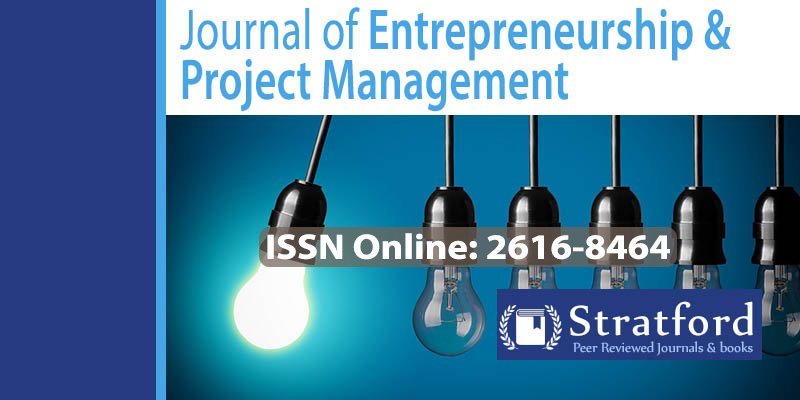Effect of Risk Management Practices on Project Performance. A Case of Twiceceka Project/WFWI- in Huye District, Rwanda
DOI:
https://doi.org/10.53819/81018102t2240Abstract
The main objective of the study was to analyze the effect of risk management on project performance in Rwanda, with special attention to the TWICECEKA project in Huye District. A project implemented by Women for Women International with funding from USAID. The specific objectives of this study are: to assess the effect of risk identification on the performance of the TWICECEKA project in Huye; to establish the effect of risk analysis on the performance of the TWICECEKA project in Huye District; to assess the effect of risk response and planning on the performance of the TWICECEKA project in Huye District; and to assess the effect of risk monitoring and control on the performance of the TWICECEKA project in Huye District. The researcher adopted theories of change, constraints, and goal-setting in order to achieve the objectives. The researcher used a census survey. The sample size was 200 respondents, all targeted populations included. Questionnaires were used to collect the primary data for this study. Secondary data were also used to conduct the study. The questionnaires are comprised of both open-ended and closed-ended questions. The questionnaires were piloted first to determine instrument reliability before distribution. The questionnaires were administered through the drop and pick later method. The findings of the study were analyzed both quantitatively and qualitatively. SPSS was used to analyze the data using descriptive statistics. The model summary revealed the R Square of 0.625, indicating that approximately 62.5% of the variance in Twiceceka Project performance can be explained by the predictors. The significance level is less than 0.05 (p < 0.05), indicating a highly significant relationship between the predictors and the performance of the Twiceceka Project. The coefficient for risk identification (β1=0.353, p<0.05). The coefficient for risk analysis (β2= 0.501, p<0.05). The coefficient for risk response planning (β3=0.425, <0.05). The coefficient for risk monitoring and control (β4= 0.297, p<0.05) indicating that there is effect of risk identification, risk analysis, risk response planning, risk monitoring and control on performance of the Twiceceka Project. The null hypotheses H01, H02, H03, and H04, which stated no significant effect of the respective risk management practices, can be rejected based on the low p-value (<0.05). It is recommended to focus on enhancing the depth and quality of risk analysis within the Twiceceka Project. This will provide a solid foundation for informed decision-making and effective risk response planning.
Key Words: Risk Management, risk identification, risk analysis, risk response, risk monitoring and control, Project performance.
References
Akintoye, A.S., & Macleod, M. (1997). Risk analysis and Management in construction, International Journal of Project Management, 15 (1): 31- 38.
Belassi, W. & Tukel, O. I. (1996). A new framework for determining success / failure factors in projects. International Journal of Project management .14(3), 141-151.
Bowden, A.R., Lane, M.R. & Martin, J.H. (2001). Triple Bottom Line Risk Management. Enhancing Profit, Environmental Performance, and Community Benefits. New York: John Wiley & Sons.
Clifford, F. & Erik, W.L (2011). Project management. The managerial process, 5th edition.
Crawford, L. (2003). Profiling the competent project manager proceedings of PMI research conference. Newton Square, P.A: Project Management Institute.
Creswell, J. W., & Plano C., V. L. (2017). Designing and Conducting Mixed Methods Research. Sage Publications.
Dvir, D. (1997). Mapping the dimension of Project performance. Project management Journal 28, 5 13
Gravette, H. (2007). Trust in Leadership and team performance: Evidence from NCAA Basketball. Journal of Applied Psychology, 85(6), 1004-1012. 48
Harold, K. (2010). Project management best practices: Achieving Global Excellence, 2nd Edition.
Jenner S., Why do projects ‘fail’ and more to the point what can we do about it? The case for disciplined, ‘fast and frugal’ decision-making, PM World Journal, 5, 3, 2015.
Lavanya, N. & Malarvizhi, T., (2008). Risk analysis and management: a vital key to effective project management. Paper presented at PMI® Global
Project Management Institute (2014): Pulse of the Profession 2014 – The High Cost of Low Performance
Project Management Institute (2015): Pulse of the Profession 2015: Capturing the Value of Project Management
Robertson, S. & Williams, T. (2006). Understanding project failure: Using Cognitive Mapping in an insurance project. Project Management Journal, 37(4), 55-71.
West, S. & Cleden, D., (2009). Managing project uncertainty. Abingdon: Ashgate Publishing Group Community Benefits. New York: John Wiley & Sons.
Zwikael, S. G. (2002). Impact of the project manager on project management planning process. Project management journal, 17(4), 78-85


